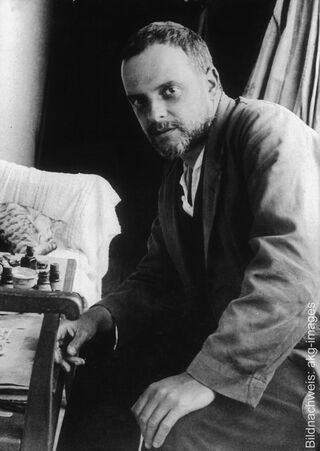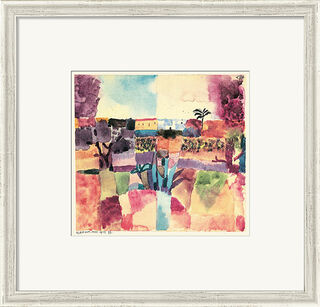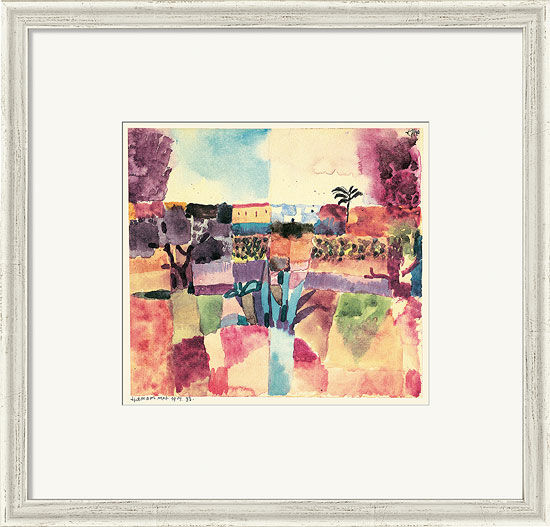Picture "Hammamet" (1914), framed


Picture "Hammamet" (1914), framed
Quick info
limited, 500 copies | facsimile print on handmade paper | framed | glazed | size approx. 45.2 x 47.3 cm (h/w)
Detailed description
Picture "Hammamet" (1914), framed
Paul Klee, Louis Moilliet and August Macke's trip to Tunis made art history: Under the African sun, they revolutionised their painting style one after the other, found countless motifs in the winding alleys and dealt with the themes of form and colour in a completely new way.
Original: 1914, Kunstmuseum Basel.
5-colour facsimile print on 270g Rives handmade paper. Limited edition of 500 copies. Framed in a silver solid wood model frame, glazed. Size approx. 45.2 x 47.3 cm (h/w).

About Paul Klee
He was called "the unique one" by his fellow artists: Paul Klee (1879-1940) shaped the understanding of modern art like hardly anyone else. With his mosaic-like composed works, he created a completely new style.
Born in Bern in 1879, Klee, a German-Swiss, turned out to be a double talent from an early age on: both his drawing skills and his violin skills promised him a musical as well as an artistic career. Klee decided on art and went to the Munich Art Academy, where he studied as a student of Franz von Stuck, among others. But it was not so much his academic studies that helped him develop an independent style but rather an extended study trip to Italy with his artist friends. Subtle symbolic depictions full of wit and humour became his trademark. Usually, just small formats and often merely drawings, enchant the viewer.
In 1906 Klee married the pianist Lily Stumpf and they had a son, Felix. The young family lived a very secluded life in Munich. It was only through the draughtsman Alfred Kubin that Klee became acquainted with the group known as the "Blaue Reiter". Klee quickly became friends with Kandinsky and Marc, with whom he shared the conviction that artistic creation was of spiritual nature.
A trip to the North African city of Tunis in 1914 with his painter friends August Macke and Louis Moilliet helped Klee to find new joy in colour and a genuine creative frenzy. "Color possesses me. I don't have to pursue it. It will possess me always, I know it. That is the meaning of this happy hour: Color and I are one. I am a painter." he writes in his diary. This was followed by countless watercolour paintings, with which he developed his own unique style.
Exhibitions organized by the Blaue Reiter made Klee famous. By the time he is appointed as a "master" by the Bauhaus, he already was a celebrated artist. In 1933, the National Socialist campaign against "degenerate art" forced Klee to leave Germany and settle back in Switzerland. With a true work mania, he tried to rebel against an incurable illness that conquers the painter, who is now internationally famous, only a few years later (1940).
The German artists‘ association "Der Blaue Reiter" ("The Blue Rider") was founded in Munich in 1911 by Wassily Kandinsky and Franz Marc during the German Expressionist period.
The name was originally the title of the painting by Kandinsky and also the title of the almanac published by Kandinsky and Marc. Members included Paul Klee and August Macke. The group criticised the prevailing art canon as too academic and elitist and demanded more openness and diversity. The artists turned away from realism and began to paint expressively in an increasingly abstract style using strong colours.
The group disbanded at the beginning of World War I.
Artistic movement that replaced Impressionism in the early 20th century.
Expressionism is the German form of the art revolution in painting, graphic art and sculpture, which found its precursor in the works of Paul Cézanne, Vincent van Gogh and Paul Gauguin in the late 19th century. The Expressionists attempted to advance to the primal elements of painting. With vibrant, unbroken colours in large areas and with the emphasis on the line and the resulting targeted suggestive expressiveness, they fought against the artistic taste established by the bourgeoisie.
The most important representatives of Expressionism were the founders of "Die Brücke" (The Bridge): Ernst Ludwig Kirchner, Erich Heckel, Karl Schmidt-Rottluff, Max Pechstein, Otto Mueller and Franz Marc, August Macke and others.
Masters of Viennese Expressionism are Egon Schiele and Oskar Kokoschka. Among the sculptors, Ernst Barlach is the most famous.
Fauvism is the French form of Expressionism.
Latin: "to make alike".
Largely faithful reproduction of an original document, e.g. old manuscripts and codices. (Facsimile edition).


